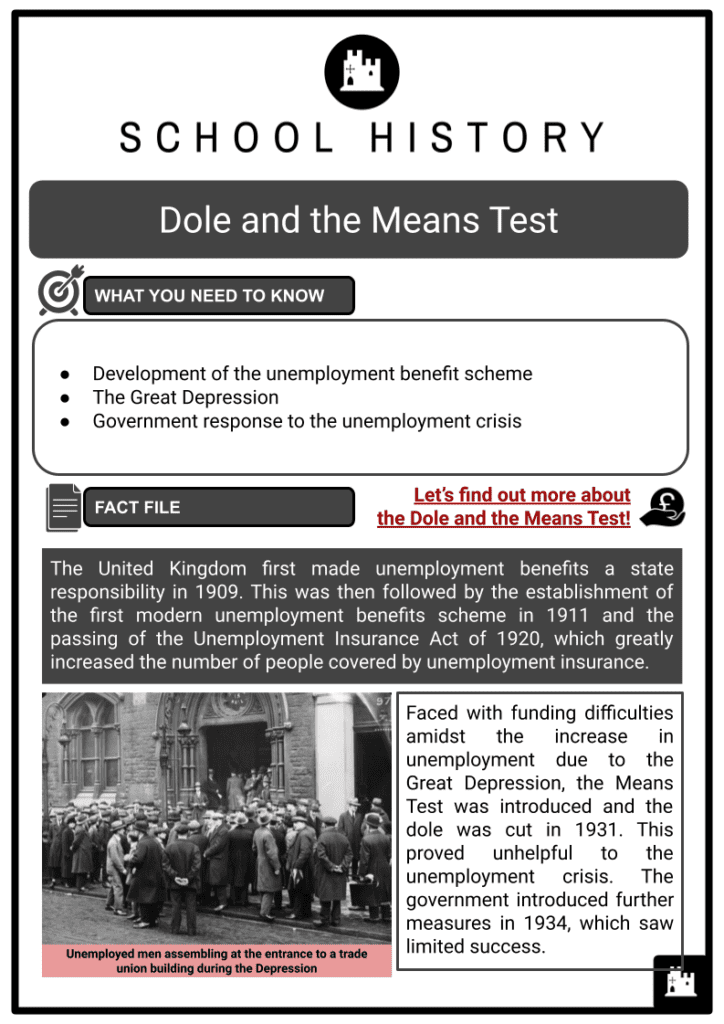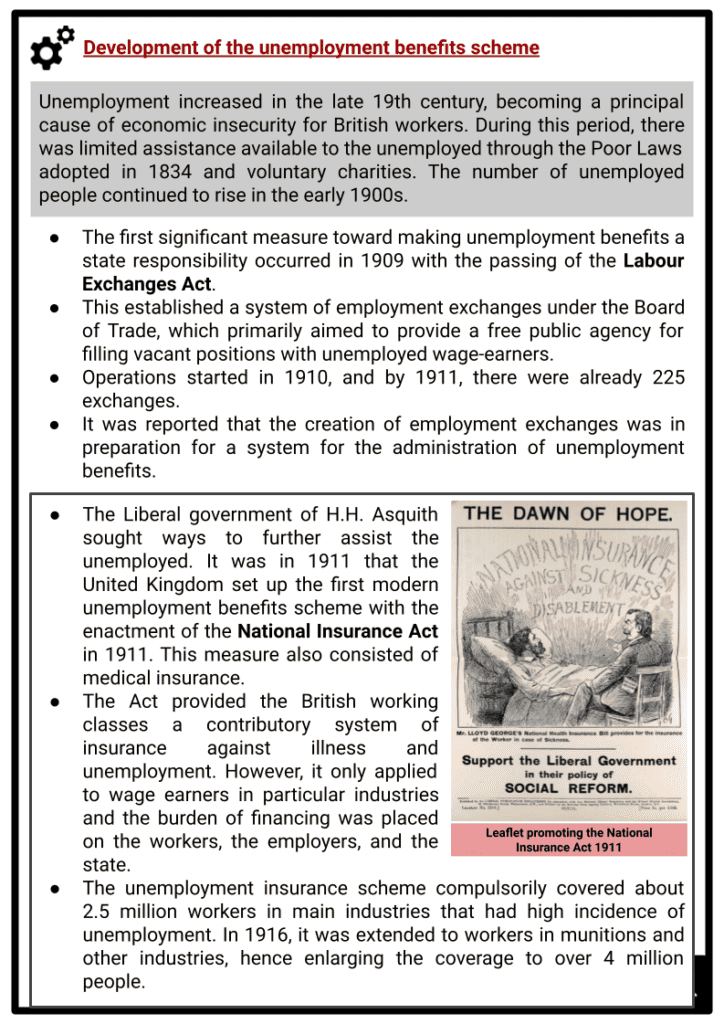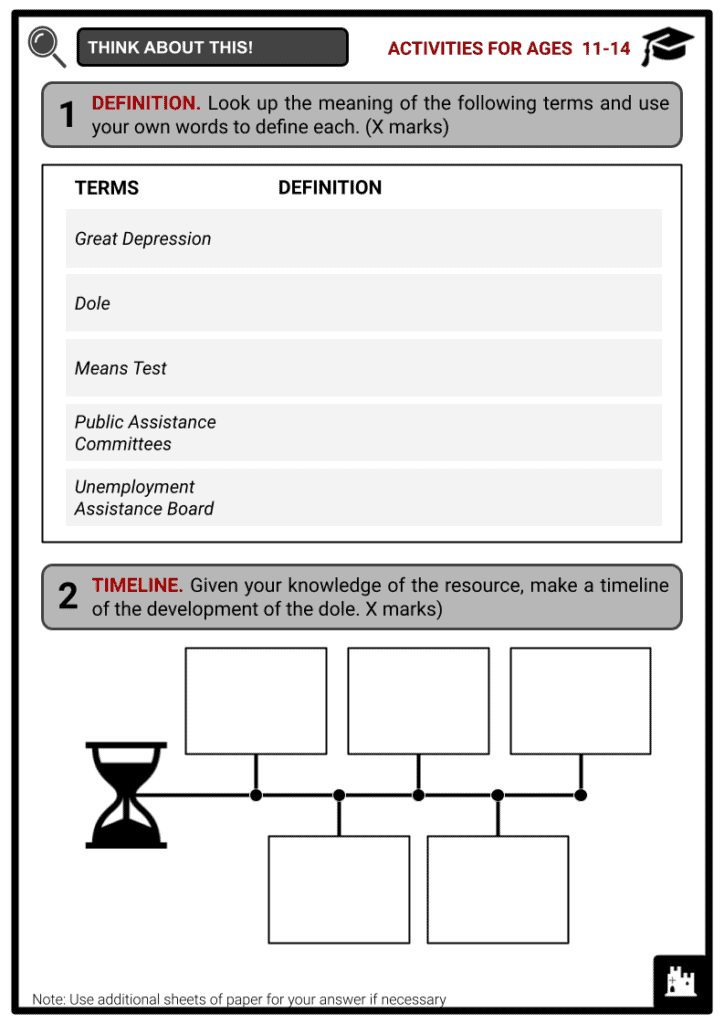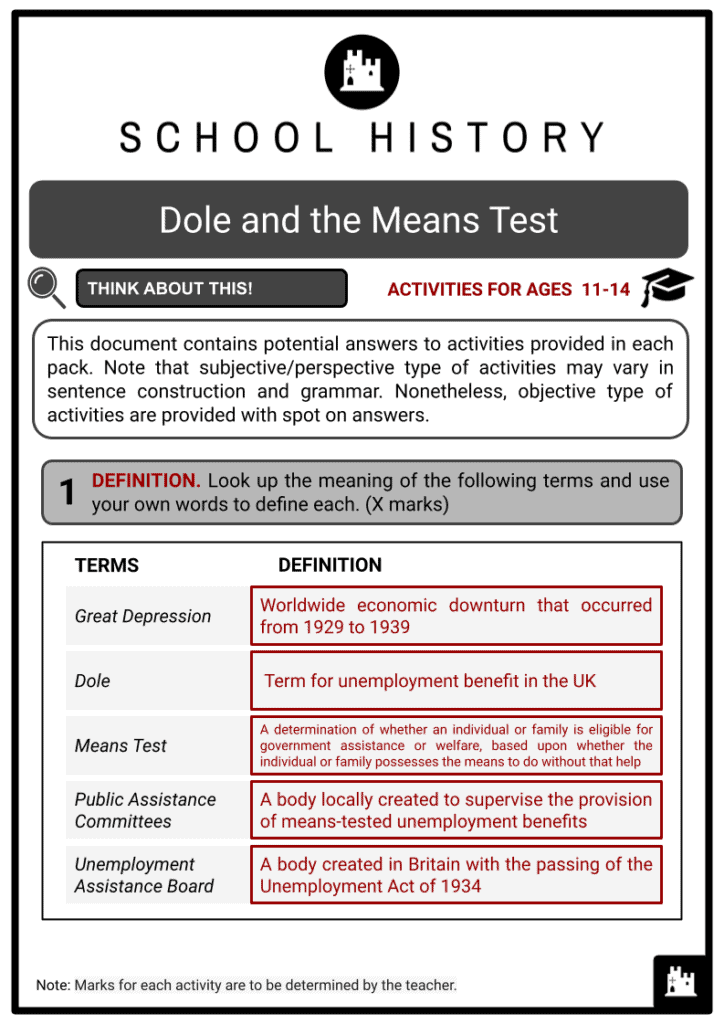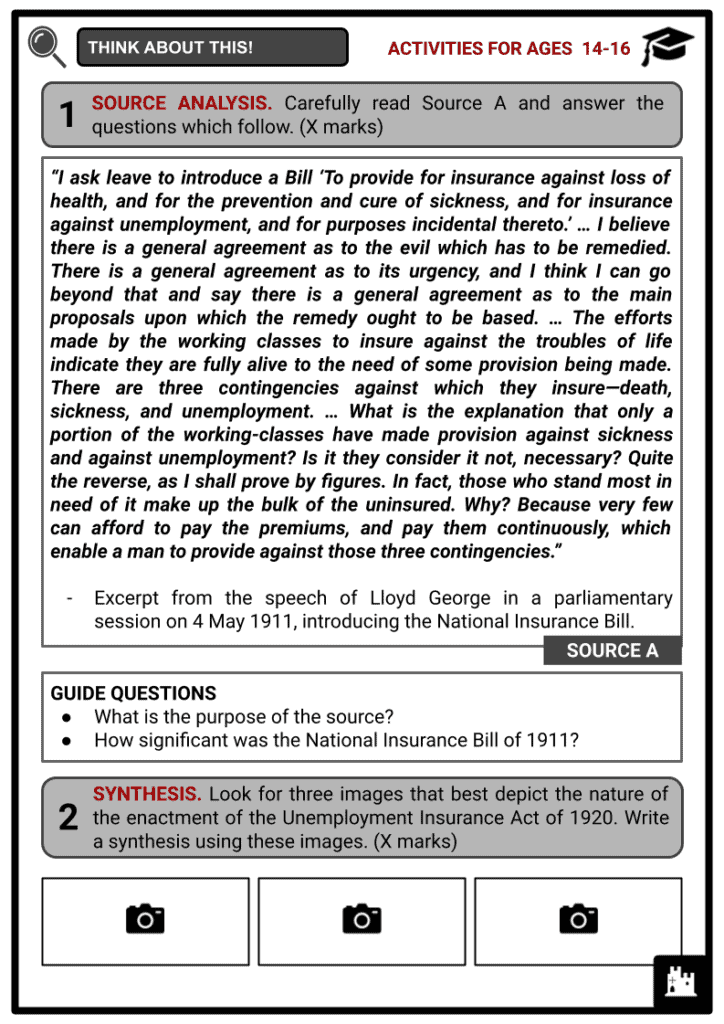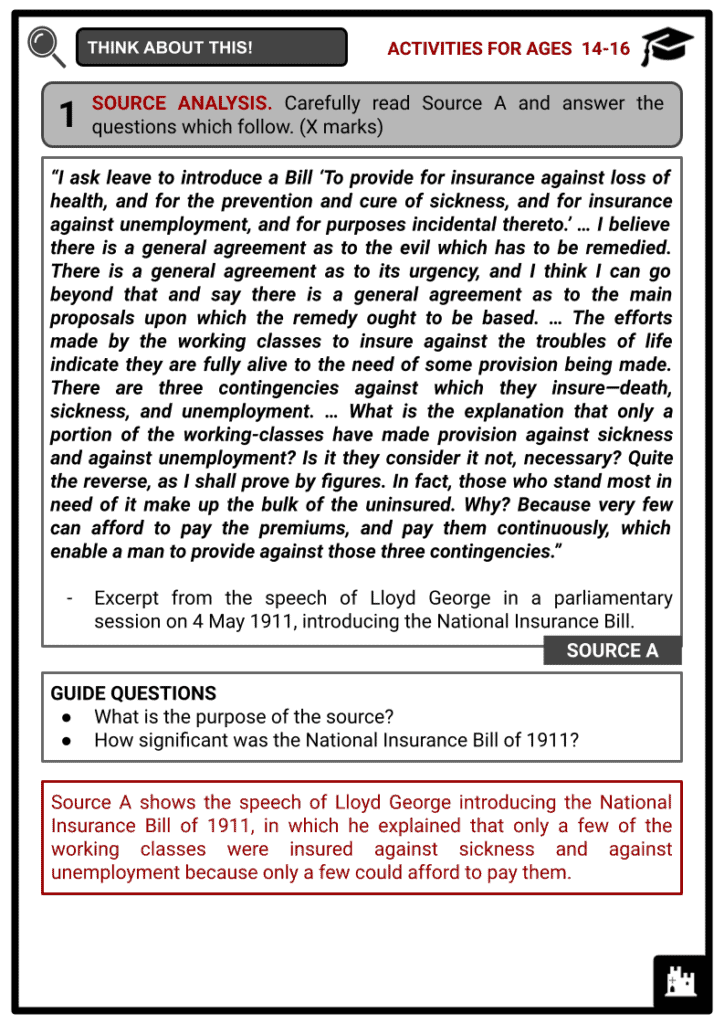Dole and the Means Test Worksheets
Do you want to save dozens of hours in time? Get your evenings and weekends back? Be able to teach about Dole and the Means Test to your students?
Our worksheet bundle includes a fact file and printable worksheets and student activities. Perfect for both the classroom and homeschooling!
Summary
- Development of the unemployment benefit scheme
- The Great Depression
- Government response to the unemployment crisis
Key Facts And Information
Let’s find out more about the Dole and the Means Test!
The United Kingdom first made unemployment benefits a state responsibility in 1909. This was then followed by the establishment of the first modern unemployment benefits scheme in 1911 and the passing of the Unemployment Insurance Act of 1920, which greatly increased the number of people covered by unemployment insurance.
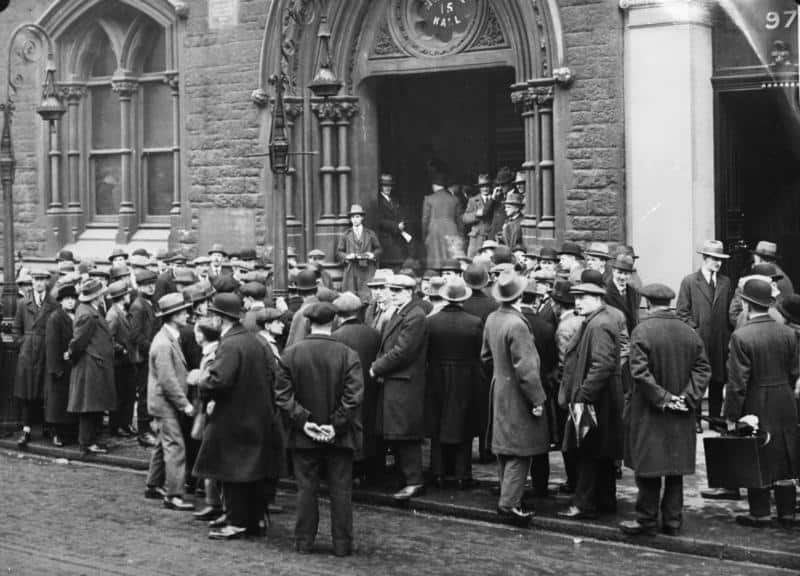
Faced with funding difficulties amidst the increase in unemployment due to the Great Depression, the Means Test was introduced and the dole was cut in 1931. This proved unhelpful to the unemployment crisis. The government introduced further measures in 1934, which saw limited success.
Development of the unemployment benefits scheme
- Unemployment increased in the late 19th century, becoming a principal cause of economic insecurity for British workers. During this period, there was limited assistance available to the unemployed through the Poor Laws adopted in 1834 and voluntary charities. The number of unemployed people continued to rise in the early 1900s.
- The first significant measure toward making unemployment benefits a state responsibility occurred in 1909 with the passing of the Labour Exchanges Act.
- This established a system of employment exchanges under the Board of Trade, which primarily aimed to provide a free public agency for filling vacant positions with unemployed wage-earners.
- Operations started in 1910, and by 1911, there were already 225 exchanges.
- It was reported that the creation of employment exchanges was in preparation for a system for the administration of unemployment benefits.
- The Liberal government of H.H. Asquith sought ways to further assist the unemployed. It was in 1911 that the United Kingdom set up the first modern unemployment benefits scheme with the enactment of the National Insurance Act in 1911. This measure also consisted of medical insurance.
- The Act provided the British working classes a contributory system of insurance against illness and unemployment. However, it only applied to wage earners in particular industries and the burden of financing was placed on the workers, the employers, and the state.
- The unemployment insurance scheme compulsorily covered about 2.5 million workers in main industries that had high incidence of unemployment. In 1916, it was extended to workers in munitions and other industries, hence enlarging the coverage to over 4 million people.
- In 1920, the Unemployment Insurance Act was passed. This superseded the previous acts, becoming the basis of all subsequent legislation. It created the dole system of payments and provided 15 weeks of unemployment benefits to over 11 million workers. The insurance benefit was funded in part by weekly contributions from both employers and workers.
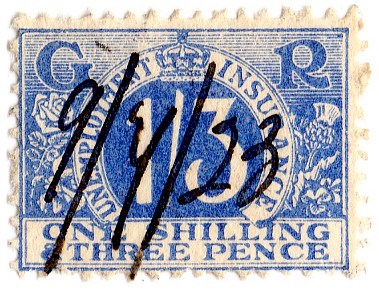
An unemployment insurance stamp from 1923 - There was only little unemployment at the time of its passing. However, the situation changed as the 1920s saw an increase in unemployment. The level of unemployment hovered between 10% and 12% for much of the decade.
- Furthermore, the duration limit accorded in the scheme was not sufficient as many of the unemployed exhausted their right to benefit payments in a few months. The local relief was also not enough to assist the huge unemployed population.
- Out of fear for the extent of social unrest that might result from mass unemployment, the government began a series of emergency unemployment insurance acts between 1921 and 1930, which relaxed the qualifying requirements for unemployment insurance benefits and increased the duration of the benefits to provide income for the unemployed. This then led to financial difficulties in funding the unemployment insurance.
The Great Depression
- The effects of the Wall Street Crash of 1929 on Britain and Europe were extensive. With Americans no longer capable to afford their lifestyles, imports from Europe declined significantly. Without business, this led to widespread unemployment. Britain was not spared, as it functioned as a major export economy. As the Great Depression took hold, British exports fell by 50%, which had disastrous consequences for jobs - as many as 2.75 million Britons were out of work and many were not insured. A factor further exacerbating the situation in Europe was American banks recalling their loans, leaving some countries with a currency crisis. This led to Britain deciding to leave the Gold Standard.
- Statistics from 1930 show that unemployment grew from 1 million to 2.5 million. Only 20% of this number were the insured workforce.
- As there were little to no unemployment benefits at the time, and because the cost of assisting the jobless rose, millions of British workers were plunged into poverty.
- Mass unemployment affected both men and women. Men who served as sole breadwinners suddenly hit by unemployment would affect the whole family.
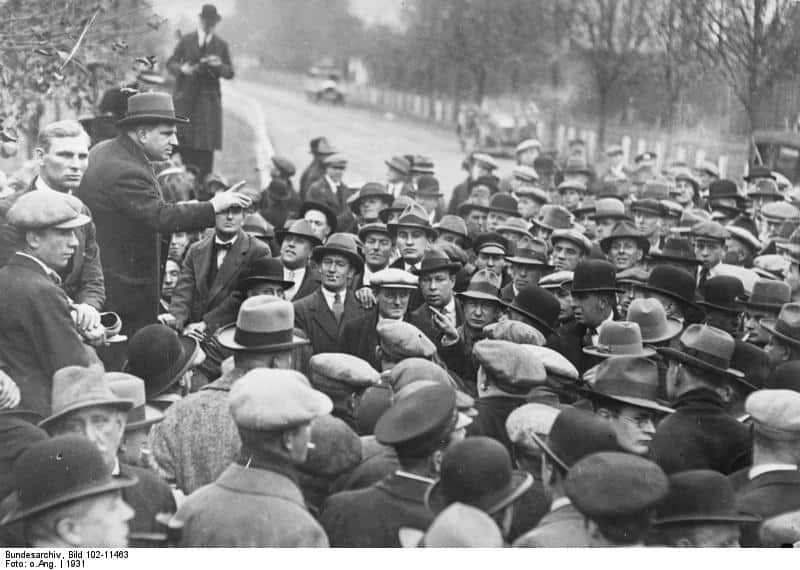
Unemployed men discussing the growing level of unemployment in 1931 - Fortunately, the government’s unemployment insurance scheme provided support to those affected.
- However, the scheme had severe limitations such as:
- Benefits were only paid according to the level of contribution, rather than the level of need.
- Benefits were only paid for a short period of time - 15 weeks. For anything longer than that, the unemployed had to rely on Poor Law relief paid by the local authority.
- The consequence was that those who were paid too poorly to afford contributions to the scheme, or who were unemployed for too long, were left destitute.
- The severity of the unemployment crisis in the 1930s meant that contributions to the insurance scheme quickly dried up and experienced a funding crisis.
- The Great Depression considerably affected the UK, resulting in a banking crisis that saw foreign investors withdraw £2.5 million per day in gold. The government had to figure out a way to reduce expenditures in the public sector.
- The solution to the funding crisis was, in August 1931, that the government unemployment insurance was replaced by a fully government-funded unemployment benefits system.
- Means Test was introduced in 1931 to screen qualified individuals.
- Public Assistance Committees (PACs) rigorously investigated a family’s finances to find out if they were entitled to help.
- The investigation included officials visiting the families to assess their conditions.
- Every detail of a family’s earnings and possessions were considered.
- This test had to be passed by a worker in order to qualify for dole.
- The sum paid to each family would be determined by this test.
- Many people were offended by the insensitive manner of this thorough investigation.
- Dole, or unemployment benefits, was lowered.
- Dole was reduced in families with some savings and small additional income. In 53% of cases, dole were stopped or cut.
- The usual rate for the dole was 15s (75p) per week for a man and wife and about 5s (25p) for each child.
- For example, for a family with one child, the dole would be 20s per week. The estimated weekly food expense for a family of two adults and three children was 22s 7d (£1.12).
- The 10% cut in the dole in 1931 was a result of the May Report of the Committee on National Expenditure.
- This made matters worse for the people that were stricken with unemployment.
- The Means Test created tensions as many struggling families were refused the dole: the assessment was harsh; a family with an older child working and a mother who had a part-time job could be refused the dole, and; old items and heirlooms were accounted for and had to be sold to receive the dole. It cut costs for the government but did not solve the problem of unemployment. Meanwhile, many people who were disappointed with the government’s failure to address the impact of the Depression, resorted to mass demonstration to force the government into positive action. A series of hunger marches in the 1920s-1930s were organised.
Government response to the unemployment crisis
- More people became unemployed for long periods of time which led to an increase in the cost required to fund the unemployment benefits. As a response to the growing problem, the government passed the Unemployment Act of 1934 which separated benefits earned by paying the unemployment insurance purely based on need. Moreover, the Special Areas Act of 1934 was enacted to grant aid to areas of Britain which had the highest levels of unemployment in the 1930s.
- The Unemployment Act of 1934:
- The Unemployment Insurance Statutory Committee was created to manage the unemployment benefits earned through contribution during the worker’s employment.
- The Unemployment Assistance Board (UAB) was set up to provide means-tested dole for those not entitled to unemployment benefits. This meant that a worker who had been long unemployed might require assistance other than, and in addition to, cash payments.
- The 10% cut in dole was reversed.
- The UAB officials administered the dole and Means Test.
- The UAB took over some of the work of the employment exchanges, establishing training schemes and providing help to the unemployed to find work in another area.
- The Special Areas Act of 1934:
- South Wales, Tyneside, West Cumberland and southern Scotland were identified as areas with special employment requirements.
- The act invested in projects like the new steelworks in Ebbw Vale.
- Commissioners, one for Scotland and one for England and Wales, were appointed and tasked with a wide range of activities on general economic development and on social improvement in the Special Areas. They were forbidden to provide assistance to private enterprises carried for gain.
- The UAB were eventually seen as an extra burden in some areas where the application of the Means Test was stricter, and reports from the Trades Union Congress in the 1930s reveal that there was still a significant deal of discontent with the low levels of benefit. Meanwhile, the success of the Special Areas Act of 1934 was limited due to insufficient investment. The unemployment crisis in Britain did not begin to subside until the latter part of the 1930s, in part because of government investments in rearmament.
Image Sources
- https://upload.wikimedia.org/wikipedia/commons/a/a7/Bundesarchiv_Bild_102-10246%2C_England%2C_Arbeitslose_vor_Gewerkschaftshaus.jpg
- https://upload.wikimedia.org/wikipedia/commons/f/f5/1923_Unemployment_Insurance_stamp.jpg
- https://upload.wikimedia.org/wikipedia/commons/4/48/Bundesarchiv_Bild_102-11463%2C_England%2C_Arbeitslose_bei_Diskussionen.jpg

